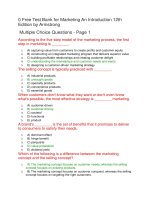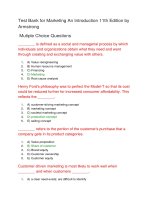mathematical biology i. an introduction third edition - j.d. murray
Bạn đang xem bản rút gọn của tài liệu. Xem và tải ngay bản đầy đủ của tài liệu tại đây (4.4 MB, 577 trang )
Mathematical Biology:
I. An Introduction,
Third Edition
J.D. Murray
Springer
Interdisciplinary Applied Mathematics
Volume 17
Editors
S.S. Antman J.E. Marsden
L. Sirovich S. Wiggins
Geophysics and Planetary Sciences
Mathematical Biology
L. Glass,J.D.Murray
Mechanics and Materials
R.V. Kohn
Systems and Control
S.S. Sastry, P.S. Krishnaprasad
Problems in engineering, computational science, and the physical and biological sci-
ences are using increasingly sophisticated mathematical techniques. Thus, the bridge
between the mathematical sciences and other disciplines is heavily traveled. The corre-
spondingly increased dialog between the disciplines has led to the establishment of the
series: Interdisciplinary Applied Mathematics.
The purpose of this series is to meet the current and future needs for the interaction
between various science and technology areas on the one hand and mathematics on the
other. This is done, firstly, by encouraging the ways that mathematics may be applied in
traditional areas, as well as point towards new and innovative areas of applications; and
secondly, by encouraging other scientific disciplines to engage in a dialog with mathe-
maticians outlining their problems to both access new methods and suggest innovative
developments within mathematics itself.
The series will consist of monographs and high-level texts from researchers working on
the interplay between mathematics and other fields of science and technology.
Interdisciplinary Applied Mathematics
Volumes published are listed at the end of the book.
Springer
New York
Berlin
Heidelberg
Barcelona
Hong Kong
London
Milan
Paris
Singapore
Tokyo
J.D. Murray
Mathematical Biology
I. An Introduction
Third Edition
With 189 Illustrations
1
Springer
J.D. Murray, FRS
Emeritus Professor
University of Oxford and
University of Washington
Box 352420
Department of Applied Mathematics
Seattle, WA 98195-2420 USA
Editors
S.S. Antman J.E. Marsden
Department of Mathematics and Control and Dynamical Systems
Institute for Physical Science Mail Code 107-81
and Technology California Institute of Technology
University of Maryland Pasadena, CA 91125
College Park, MD 20742 USA
USA
L. Sirovich S. Wiggins
Division of Applied Mathematics Control and Dynamical Systems
Brown University Mail Code 107-81
Providence, RI 02912 California Institute of Technology
USA Pasadena, CA 91125
USA
Cover illustration:
c
2001 Superstock.
Mathematics Subject Classification (2000): 92B05, 92-01, 92C05, 92D30, 34Cxx
Library of Congress Cataloging-in-Publication Data
Murray, J.D. (James Dickson)
Mathematical biology. I. An introduction / J.D. Murray.—3rd ed.
p. cm.—(Interdisciplinary applied mathematics)
Rev. ed. of: Mathematical biology. 2nd ed. c1993.
Includes bibliographical references (p. ).
ISBN 0-387-95223-3 (alk. paper)
1. Biology—Mathematical models. I. Murray, J.D. (James Dickson) Mathematical
biology. II. Title. III. Series.
QH323.5 .M88 2001
570
.1
5118—dc21 2001020448
Printed on acid-free paper.
c
2002 J.D. Murray,
c
1989, 1993 Springer-Verlag Berlin Heidelberg.
All rights reserved. This work may not be translated or copied in whole or in part without the written per-
mission of the publisher (Springer-Verlag New York, Inc., 175 Fifth Avenue, New York, NY 10010, USA)
and of the copyright holder, except for brief excerpts in connection with reviews or scholarly analysis. Use in
connection with any form of information storage and retrieval, electronic adaptation, computer software, or
by similar or dissimilar methodology now known or hereafter developed is forbidden.
The use in this publication of trade names, trademarks, service marks, and similar terms, even if they are
not identified as such, is not to be taken as an expression of opinion as to whether or not they are subject to
propriety rights.
Production managed by Jenny Wolkowicki; manufacturing supervised by Jerome Basma.
Typeset pages prepared using the author’s L
A
T
E
X files by Integre Technical Publishing Company, Inc.,
Albuquerque, NM.
Printed and bound by Maple-Vail Book Manufacturing Group, York, PA.
Printed in the United States of America.
987654321
ISBN 0-387-95223-3 SPIN 10750592
Springer-Verlag New York Berlin Heidelberg
A member of BertelsmannSpringer Science+Business Media GmbH
To my wife Sheila, whom I married more
than forty years ago and lived happily ever
after, and to our children Mark and Sarah
que se
´
el fuera de su consejo al tiempo de la
general criaci
´
on del mundo, i de lo que en
´
el se
encierra, i se hall
´
aracon
´
el, se huvieran producido
i formado algunas cosas mejor que fueran hechas,
i otras ni se hicieran, u se enmendaran i corrigieran.
—Alphonso X (Alphonso the Wise), 1221–1284
King of Castile and Leon (attributed)
If the Lord Almighty had consulted me
before embarking on creation I should
have recommended something simpler.
Preface to the Third Edition
In the thirteen years since the first edition of this book appeared the growth of mathe-
matical biology and the diversity of applications has been astonishing. Its establishment
as a distinct discipline is no longer in question. One pragmatic indication is the in-
creasing number of advertised positions in academia, medicine and industry around the
world; another is the burgeoning membership of societies. People working in the field
now number in the thousands. Mathematical modelling is being applied in every ma-
jor discipline in the biomedical sciences. A very different application, and surprisingly
successful, is in psychology such as modelling various human interactions, escalation
to date rape and predicting divorce.
The field has become so large that, inevitably, specialised areas have developed
which are, in effect, separate disciplines such as biofluid mechanics, theoretical ecology
and so on. It is relevant therefore to ask why I felt there was a case for a new edition of
a book called simply Mathematical Biology. It is unrealistic to think that a single book
could cover even a significant part of each subdiscipline and this new edition certainly
does not even try to do this. I feel, however, that there is still justification for a book
which can demonstrate to the uninitiated some of the exciting problems that arise in
biology and give some indication of the wide spectrum of topics that modelling can
address.
In many areas the basics are more or less unchanged but the developments during
the past thirteen years have made it impossible to give as comprehensive a picture of the
current approaches in and the state of the field as was possible in the late 1980s. Even
then important areas were not included such as stochastic modelling, biofluid mechanics
and others. Accordingly in this new edition only some of the basic modelling concepts
are discussed—such as in ecology and to a lesser extent epidemiology—but references
are provided for further reading. In other areas recent advances are discussed together
with some new applications of modelling such as in marital interaction (Volume I),
growth of cancer tumours (Volume II), temperature-dependent sex determination (Vol-
ume I) and wolf territoriality (Volume II). There have been many new and fascinating
developments that I would have liked to include but practical space limitations made
it impossible and necessitated difficult choices. I have tried to give some idea of the
diversity of new developments but the choice is inevitably prejudiced.
As to general approach, if anything it is even more practical in that more emphasis
is given to the close connection many of the models have with experiment, clinical
data and in estimating real parameter values. In several of the chapters it is not yet
viii Preface to the Third Edition
possible to relate the mathematical models to specific experiments or even biological
entities. Nevertheless such an approach has spawned numerous experiments based as
much on the modelling approach as on the actual mechanism studied. Some of the more
mathematical parts in which the biological connection was less immediate have been
excised while others that have been kept have a mathematical and technical pedagogical
aim but all within the context of their application to biomedical problems. I feel even
more strongly about the philosophy of mathematical modelling espoused in the original
preface as regards what constitutes good mathematical biology. One of the most exciting
aspects regarding the new chapters has been their genuine interdisciplinary collaborative
character. Mathematical or theoretical biology is unquestionably an interdisciplinary
science par excellence.
The unifying aim of theoretical modelling and experimental investigation in the
biomedical sciences is the elucidation of the underlying biological processes that re-
sult in a particular observed phenomenon, whether it is pattern formation in develop-
ment, the dynamics of interacting populations in epidemiology, neuronal connectivity
and information processing, the growth of tumours, marital interaction and so on. I
must stress, however, that mathematical descriptions of biological phenomena are not
biological explanations. The principal use of any theory is in its predictions and, even
though different models might be able to create similar spatiotemporal behaviours, they
are mainly distinguished by the different experiments they suggest and, of course, how
closely they relate to the real biology. There are numerous examples in the book.
Why use mathematics to study something as intrinsically complicated and ill un-
derstood as development, angiogenesis, wound healing, interacting population dynam-
ics, regulatory networks, marital interaction and so on? We suggest that mathematics,
rather theoretical modelling, must be used if we ever hope to genuinely and realistically
convert an understanding of the underlying mechanisms into a predictive science. Math-
ematics is required to bridge the gap between the level on which most of our knowledge
is accumulating (in developmental biology it is cellular and below) and the macroscopic
level of the patterns we see. In wound healing and scar formation, for example, a mathe-
matical approach lets us explore the logic of the repair process. Even if the mechanisms
were well understood (and they certainly are far from it at this stage) mathematics would
be required to explore the consequences of manipulating the various parameters asso-
ciated with any particular scenario. In the case of such things as wound healing and
cancer growth—and now in angiogensesis with its relation to possible cancer therapy—
the number of options that are fast becoming available to wound and cancer managers
will become overwhelming unless we can find a way to simulate particular treatment
protocols before applying them in practice. The latter has been already of use in under-
standing the efficacy of various treatment scenarios with brain tumours (glioblastomas)
and new two step regimes for skin cancer.
The aim in all these applications is not to derive a mathematical model that takes
into account every single process because, even if this were possible, the resulting model
would yield little or no insight on the crucial interactions within the system. Rather the
goal is to develop models which capture the essence of various interactions allowing
their outcome to be more fully understood. As more data emerge from the biological
system, the models become more sophisticated and the mathematics increasingly chal-
lenging.
Preface to the Third Edition ix
In development (by way of example) it is true that we are a long way from be-
ing able to reliably simulate actual biological development, in spite of the plethora of
models and theory that abound. Key processes are generally still poorly understood.
Despite these limitations, I feel that exploring the logic of pattern formation is worth-
while, or rather essential, even in our present state of knowledge. It allows us to take
a hypothetical mechanism and examine its consequences in the form of a mathemat-
ical model, make predictions and suggest experiments that would verify or invalidate
the model; even the latter casts light on the biology. The very process of constructing
a mathematical model can be useful in its own right. Not only must we commit to a
particular mechanism, but we are also forced to consider what is truly essential to the
process, the central players (variables) and mechanisms by which they evolve. We are
thus involved in constructing frameworks on which we can hang our understanding. The
model equations, the mathematical analysis and the numerical simulations that follow
serve to reveal quantitatively as well as qualitatively the consequences of that logical
structure.
This new edition is published in two volumes. Volume I is an introduction to the
field; the mathematics mainly involves ordinary differential equations but with some
basic partial differential equation models and is suitable for undergraduate and graduate
courses at different levels. Volume II requires more knowledge of partial differential
equations and is more suitable for graduate courses and reference.
I would like to acknowledge the encouragement and generosity of the many peo-
ple who have written to me (including a prison inmate in New England) since the ap-
pearance of the first edition of this book, many of whom took the trouble to send me
details of errors, misprints, suggestions for extending some of the models, suggesting
collaborations and so on. Their input has resulted in many successful interdisciplinary
research projects several of which are discussed in this new edition. I would like to
thank my colleagues Mark Kot and Hong Qian, many of my former students, in partic-
ular Patricia Burgess, Julian Cook, Trac
´
e Jackson, Mark Lewis, Philip Maini, Patrick
Nelson, Jonathan Sherratt, Kristin Swanson and Rebecca Tyson for their advice or care-
ful reading of parts of the manuscript. I would also like to thank my former secretary
Erik Hinkle for the care, thoughtfulness and dedication with which he put much of the
manuscript into L
A
T
E
X and his general help in tracking down numerous obscure refer-
ences and material.
I am very grateful to Professor John Gottman of the Psychology Department at the
University of Washington, a world leader in the clinical study of marital and family in-
teractions, with whom I have had the good fortune to collaborate for nearly ten years.
Without his infectious enthusiasm, strong belief in the use of mathematical modelling,
perseverance in the face of my initial scepticism and his practical insight into human in-
teractions I would never have become involved in developing with him a general theory
of marital interaction. I would also like to acknowledge my debt to Professor Ellworth
C. Alvord, Jr., Head of Neuropathology in the University of Washington with whom I
have collaborated for the past seven years on the modelling of the growth and control of
brain tumours. As to my general, and I hope practical, approach to modelling I am most
indebted to Professor George F. Carrier who had the major influence on me when I went
to Harvard on first coming to the U.S.A. in 1956. His astonishing insight and ability to
extract the key elements from a complex problem and incorporate them into a realistic
x Preface to the Third Edition
and informative model is a talent I have tried to acquire throughout my career. Finally,
although it is not possible to thank by name all of my past students, postdoctorals, nu-
merous collaborators and colleagues around the world who have encouraged me in this
field, I am certainly very much in their debt.
Looking back on my involvement with mathematics and the biomedical sciences
over the past nearly thirty years my major regret is that I did not start working in the
field years earlier.
Bainbridge Island, Washington J.D. Murray
January 2002
Preface to the First Edition
Mathematics has always benefited from its involvement with developing sciences. Each
successive interaction revitalises and enhances the field. Biomedical science is clearly
the premier science of the foreseeable future. For the continuing health of their subject,
mathematicians must become involved with biology. With the example of how mathe-
matics has benefited from and influenced physics, it is clear that if mathematicians do
not become involved in the biosciences they will simply not be a part of what are likely
to be the most important and exciting scientific discoveries of all time.
Mathematical biology is a fast-growing, well-recognised, albeit not clearly defined,
subject and is, to my mind, the most exciting modern application of mathematics. The
increasing use of mathematics in biology is inevitable as biology becomes more quan-
titative. The complexity of the biological sciences makes interdisciplinary involvement
essential. For the mathematician, biology opens up new and exciting branches, while for
the biologist, mathematical modelling offers another research tool commensurate with
a new powerful laboratory technique but only if used appropriately and its limitations
recognised. However, the use of esoteric mathematics arrogantly applied to biologi-
cal problems by mathematicians who know little about the real biology, together with
unsubstantiated claims as to how important such theories are, do little to promote the
interdisciplinary involvement which is so essential.
Mathematical biology research, to be useful and interesting, must be relevant bio-
logically. The best models show how a process works and then predict what may fol-
low. If these are not already obvious to the biologists and the predictions turn out to be
right, then you will have the biologists’ attention. Suggestions as to what the governing
mechanisms are may evolve from this. Genuine interdisciplinary research and the use
of models can produce exciting results, many of which are described in this book.
No previous knowledge of biology is assumed of the reader. With each topic dis-
cussed I give a brief description of the biological background sufficient to understand
the models studied. Although stochastic models are important, to keep the book within
reasonable bounds, I deal exclusively with deterministic models. The book provides a
toolkit of modelling techniques with numerous examples drawn from population ecol-
ogy, reaction kinetics, biological oscillators, developmental biology, evolution, epidemi-
ology and other areas.
The emphasis throughout the book is on the practical application of mathemati-
cal models in helping to unravel the underlying mechanisms involved in the biological
processes. The book also illustrates some of the pitfalls of indiscriminate, naive or un-
xii Preface to the First Edition
informed use of models. I hope the reader will acquire a practical and realistic view
of biological modelling and the mathematical techniques needed to get approximate
quantitative solutions and will thereby realise the importance of relating the models and
results to the real biological problems under study. If the use of a model stimulates
experiments—even if the model is subsequently shown to be wrong—then it has been
successful. Models can provide biological insight and be very useful in summarising,
interpreting and interpolating real data. I hope the reader will also learn that (certainly
at this stage) there is usually no ‘right’ model: producing similar temporal or spatial pat-
terns to those experimentally observed is only a first step and does not imply the model
mechanism is the one which applies. Mathematical descriptions are not explanations.
Mathematics can never provide the complete solution to a biological problem on its
own. Modern biology is certainly not at the stage where it is appropriate for mathemati-
cians to try to construct comprehensive theories. A close collaboration with biologists is
needed for realism, stimulation and help in modifying the model mechanisms to reflect
the biology more accurately.
Although this book is titled mathematical biology it is not, and could not be, a
definitive all-encompassing text. The immense breadth of the field necessitates a re-
stricted choice of topics. Some of the models have been deliberately kept simple for
pedagogical purposes. The exclusion of a particular topic—population genetics, for
example—in no way reflects my view as to its importance. However, I hope the range
of topics discussed will show how exciting intercollaborative research can be and how
significant a role mathematics can play. The main purpose of the book is to present
some of the basic and, to a large extent, generally accepted theoretical frameworks for a
variety of biological models. The material presented does not purport to be the latest de-
velopments in the various fields, many of which are constantly expanding. The already
lengthy list of references is by no means exhaustive and I apologise for the exclusion of
many that should be included in a definitive list.
With the specimen models discussed and the philosophy which pervades the book,
the reader should be in a position to tackle the modelling of genuinely practical prob-
lems with realism. From a mathematical point of view, the art of good modelling relies
on: (i) a sound understanding and appreciation of the biological problem; (ii) a realistic
mathematical representation of the important biological phenomena; (iii) finding use-
ful solutions, preferably quantitative; and what is crucially important; (iv) a biological
interpretation of the mathematical results in terms of insights and predictions. The math-
ematics is dictated by the biology and not vice versa. Sometimes the mathematics can
be very simple. Useful mathematical biology research is not judged by mathematical
standards but by different and no less demanding ones.
The book is suitable for physical science courses at various levels. The level of
mathematics needed in collaborative biomedical research varies from the very simple to
the sophisticated. Selected chapters have been used for applied mathematics courses in
the University of Oxford at the final-year undergraduate and first-year graduate levels. In
the U.S.A. the material has also been used for courses for students from the second-year
undergraduate level through graduate level. It is also accessible to the more theoretically
oriented bioscientists who have some knowledge of calculus and differential equations.
I would like to express my gratitude to the many colleagues around the world who
have, over the past few years, commented on various chapters of the manuscript, made
Preface to the First Edition xiii
valuable suggestions and kindly provided me with photographs. I would particularly
like to thank Drs. Philip Maini, David Lane, and Diana Woodward and my present
graduate students who read various drafts with such care, specifically Daniel Bentil,
Meghan Burke, David Crawford, Michael Jenkins, Mark Lewis, Gwen Littlewort, Mary
Myerscough, Katherine Rogers and Louisa Shaw.
Oxford, UK J.D. Murray
January 1989
This page intentionally left blank
This page intentionally left blank
Table of Contents
CONTENTS, VOLUME I
Preface to the Third Edition vii
Preface to the First Edition xi
1. Continuous Population Models for Single Species 1
1.1 Continuous Growth Models 1
1.2 InsectOutbreakModel:SpruceBudworm 7
1.3 DelayModels 13
1.4 Linear Analysis of Delay Population Models: Periodic Solutions . . . 17
1.5 Delay Models in Physiology: Periodic Dynamic Diseases . . . 21
1.6 Harvesting a Single Natural Population . . 30
1.7 Population Model with Age Distribution . . 36
Exercises 40
2. Discrete Population Models for a Single Species 44
2.1 Introduction: Simple Models . . . 44
2.2 Cobwebbing:AGraphicalProcedureofSolution 49
2.3 DiscreteLogistic-TypeModel:Chaos 53
2.4 Stability, Periodic Solutions and Bifurcations 59
2.5 DiscreteDelayModels 62
2.6 FisheryManagementModel 67
2.7 EcologicalImplicationsandCaveats 69
2.8 TumourCellGrowth 72
Exercises 75
3. Models for Interacting Populations 79
3.1 Predator–PreyModels:Lotka–VolterraSystems 79
3.2 Complexity and Stability 83
3.3 RealisticPredator–PreyModels 86
3.4 Analysis of a Predator–Prey Model with Limit Cycle
Periodic Behaviour: Parameter Domains of Stability . 88
3.5 Competition Models: Competitive Exclusion Principle 94
xvi Table of Contents, Volume I
3.6 MutualismorSymbiosis 99
3.7 GeneralModelsandCautionaryRemarks 101
3.8 ThresholdPhenomena 105
3.9 Discrete Growth Models for Interacting Populations . . 109
3.10 Predator–PreyModels:DetailedAnalysis 110
Exercises 115
4. Temperature-Dependent Sex Determination (TSD) 119
4.1 Biological Introduction and Historical Asides on the Crocodilia . . . . 119
4.2 Nesting Assumptions and Simple Population Model . . 124
4.3 Age-Structured Population Model for Crocodilia . . . 130
4.4 Density-DependentAge-StructuredModelEquations 133
4.5 Stability of the Female Population in Wet Marsh Region I 135
4.6 SexRatioandSurvivorship 137
4.7 Temperature-Dependent Sex Determination (TSD) Versus
GeneticSexDetermination(GSD) 139
4.8 RelatedAspectsonSexDetermination 142
Exercise 144
5. Modelling the Dynamics of Marital Interaction: Divorce Prediction
and Marriage Repair 146
5.1 Psychological Background and Data:
Gottman and Levenson Methodology . 147
5.2 Marital Typology and Modelling Motivation . . 150
5.3 Modelling Strategy and the Model Equations . 153
5.4 Steady States and Stability . 156
5.5 PracticalResultsfromtheModel 164
5.6 Benefits,ImplicationsandMarriageRepairScenarios 170
6. Reaction Kinetics 175
6.1 EnzymeKinetics:BasicEnzymeReaction 175
6.2 Transient Time Estimates and Nondimensionalisation . 178
6.3 Michaelis–MentenQuasi-SteadyStateAnalysis 181
6.4 SuicideSubstrateKinetics 188
6.5 Cooperative Phenomena . . 197
6.6 Autocatalysis, Activation and Inhibition 201
6.7 Multiple Steady States, Mushrooms and Isolas . 208
Exercises 215
7. Biological Oscillators and Switches 218
7.1 Motivation, Brief History and Background . . . 218
7.2 FeedbackControlMechanisms 221
7.3 Oscillators and Switches with Two or More Species:
General Qualitative Results . 226
7.4 Simple Two-Species Oscillators: Parameter Domain
Determination for Oscillations 234
Table of Contents, Volume I xvii
7.5 Hodgkin–Huxley Theory of Nerve Membranes:
FitzHugh–Nagumo Model 239
7.6 Modelling the Control of Testosterone Secretion and
ChemicalCastration 244
Exercises 253
8. BZ Oscillating Reactions 257
8.1 Belousov Reaction and the Field–K
¨
or
¨
os–Noyes(FKN)Model 257
8.2 Linear Stability Analysis of the FKN Model and Existence
ofLimitCycleSolutions 261
8.3 Nonlocal Stability of the FKN Model . . . 265
8.4 Relaxation Oscillators: Approximation for the
Belousov–ZhabotinskiiReaction 268
8.5 Analysis of a Relaxation Model for Limit Cycle Oscillations
intheBelousov–ZhabotinskiiReaction 271
Exercises 277
9. Perturbed and Coupled Oscillators and Black Holes 278
9.1 Phase Resetting in Oscillators . . 278
9.2 Phase Resetting Curves . 282
9.3 BlackHoles 286
9.4 Black Holes in Real Biological Oscillators . 288
9.5 Coupled Oscillators: Motivation and Model System . 293
9.6 Phase Locking of Oscillations: Synchronisation in Fireflies . . 295
9.7 Singular Perturbation Analysis: Preliminary Transformation . 299
9.8 Singular Perturbation Analysis: Transformed System 302
9.9 Singular Perturbation Analysis: Two-Time Expansion 305
9.10 Analysis of the Phase Shift Equation and Application
to Coupled Belousov–Zhabotinskii Reactions 310
Exercises 313
10. Dynamics of Infectious Diseases 315
10.1 HistoricalAsideonEpidemics 315
10.2 SimpleEpidemicModelsandPracticalApplications 319
10.3 Modelling Venereal Diseases . . . 327
10.4 Multi-Group Model for Gonorrhea and Its Control . . 331
10.5 AIDS: Modelling the Transmission Dynamics of the Human
Immunodeficiency Virus (HIV) . . 333
10.6 HIV: Modelling Combination Drug Therapy 341
10.7 DelayModelforHIVInfectionwithDrugTherapy 350
10.8 Modelling the Population Dynamics of Acquired Immunity to
ParasiteInfection 351
10.9 Age-DependentEpidemicModelandThresholdCriterion 361
10.10SimpleDrugUseEpidemicModelandThresholdAnalysis 365
10.11 Bovine Tuberculosis Infection in Badgers and Cattle 369
xviii Table of Contents, Volume I
10.12 Modelling Control Strategies for Bovine Tuberculosis
in Badgers and Cattle 379
Exercises 393
11. Reaction Diffusion, Chemotaxis, and Nonlocal Mechanisms 395
11.1 Simple Random Walk and Derivation of the Diffusion Equation . . . 395
11.2 ReactionDiffusionEquations 399
11.3 ModelsforAnimalDispersal 402
11.4 Chemotaxis 405
11.5 NonlocalEffectsandLongRangeDiffusion 408
11.6 Cell Potential and Energy Approach to Diffusion
andLongRangeEffects 413
Exercises 416
12. Oscillator-Generated Wave Phenomena 418
12.1 Belousov–ZhabotinskiiReactionKinematicWaves 418
12.2 Central Pattern Generator: Experimental Facts in the Swimming
ofFish 422
12.3 MathematicalModelfortheCentralPatternGenerator 424
12.4 Analysis of the Phase Coupled Model System . 431
Exercises 436
13. Biological Waves: Single-Species Models 437
13.1 Background and the Travelling Waveform . . . 437
13.2 Fisher–Kolmogoroff Equation and Propagating Wave Solutions . . . . 439
13.3 Asymptotic Solution and Stability of Wavefront Solutions
of the Fisher–Kolmogoroff Equation . 444
13.4 Density-Dependent Diffusion-Reaction Diffusion Models
andSomeExactSolutions 449
13.5 Waves in Models with Multi-Steady State Kinetics:
Spread and Control of an Insect Population . . 460
13.6 Calcium Waves on Amphibian Eggs: Activation Waves
on Medaka Eggs 467
13.7 Invasion Wavespeeds with Dispersive Variability . . . 471
13.8 SpeciesInvasionandRangeExpansion 478
Exercises 482
14. Use and Abuse of Fractals 484
14.1 Fractals:BasicConceptsandBiologicalRelevance 484
14.2 ExamplesofFractalsandTheirGeneration 487
14.3 Fractal Dimension: Concepts and Methods of Calculation 490
14.4 Fractals or Space-Filling? . . 496
Appendices 501
A. Phase Plane Analysis 501
Contents, Volume II xix
B. Routh-Hurwitz Conditions, Jury Conditions, Descartes’
Rule of Signs, and Exact Solutions of a Cubic 507
B.1 Polynomials and Conditions . . . 507
B.2 Descartes’RuleofSigns 509
B.3 Roots of a General Cubic Polynomial . . . 510
Bibliography 513
Index 537
CONTENTS, VOLUME II
J.D. Murray: Mathematical Biology, II: Spatial Models and
Biomedical Applications
Preface to the Third Edition
Preface to the First Edition
1. Multi-Species Waves and Practical Applications
1.1 Intuitive Expectations
1.2 Waves of Pursuit and Evasion in Predator–Prey Systems
1.3 Competition Model for the Spatial Spread of the Grey Squirrel
in Britain
1.4 Spread of Genetically Engineered Organisms
1.5 Travelling Fronts in the Belousov–Zhabotinskii Reaction
1.6 Waves in Excitable Media
1.7 Travelling Wave Trains in Reaction Diffusion Systems with
Oscillatory Kinetics
1.8 Spiral Waves
1.9 Spiral Wave Solutions of λ-ω Reaction Diffusion Systems
2. Spatial Pattern Formation with Reaction Diffusion Systems
2.1 Role of Pattern in Biology
2.2 Reaction Diffusion (Turing) Mechanisms
2.3 General Conditions for Diffusion-Driven Instability:
Linear Stability Analysis and Evolution of Spatial Pattern
2.4 Detailed Analysis of Pattern Initiation in a Reaction Diffusion
Mechanism
2.5 Dispersion Relation, Turing Space, Scale and Geometry Effects
in Pattern Formation Models
2.6 Mode Selection and the Dispersion Relation
2.7 Pattern Generation with Single-Species Models: Spatial
Heterogeneity with the Spruce Budworm Model
2.8 Spatial Patterns in Scalar Population Interaction Diffusion
Equations with Convection: Ecological Control Strategies
xx Contents, Volume II
2.9 Nonexistence of Spatial Patterns in Reaction Diffusion Systems:
General and Particular Results
3. Animal Coat Patterns and Other Practical Applications of Reaction
Diffusion Mechanisms
3.1 Mammalian Coat Patterns—‘How the Leopard Got Its Spots’
3.2 Teratologies: Examples of Animal Coat Pattern Abnormalities
3.3 A Pattern Formation Mechanism for Butterfly Wing Patterns
3.4 Modelling Hair Patterns in a Whorl in Acetabularia
4. Pattern Formation on Growing Domains: Alligators and Snakes
4.1 Stripe Pattern Formation in the Alligator: Experiments
4.2 Modelling Concepts: Determining the Time of Stripe Formation
4.3 Stripes and Shadow Stripes on the Alligator
4.4 Spatial Patterning of Teeth Primordia in the Alligator:
Background and Relevance
4.5 Biology of Tooth Initiation
4.6 Modelling Tooth Primordium Initiation: Background
4.7 Model Mechanism for Alligator Teeth Patterning
4.8 Results and Comparison with Experimental Data
4.9 Prediction Experiments
4.10 Concluding Remarks on Alligator Tooth Spatial Patterning
4.11 Pigmentation Pattern Formation on Snakes
4.12 Cell-Chemotaxis Model Mechanism
4.13 Simple and Complex Snake Pattern Elements
4.14 Propagating Pattern Generation with the Cell-Chemotaxis System
5. Bacterial Patterns and Chemotaxis
5.1 Background and Experimental Results
5.2 Model Mechanism for E. coli in the Semi-Solid Experiments
5.3 Liquid Phase Model: Intuitive Analysis of Pattern Formation
5.4 Interpretation of the Analytical Results and Numerical Solutions
5.5 Semi-Solid Phase Model Mechanism for S. typhimurium
5.6 Linear Analysis of the Basic Semi-Solid Model
5.7 Brief Outline and Results of the Nonlinear Analysis
5.8 Simulation Results, Parameter Spaces, Basic Patterns
5.9 Numerical Results with Initial Conditions from the Experiments
5.10 Swarm Ring Patterns with the Semi-Solid Phase Model Mechanism
5.11 Branching Patterns in Bacillus subtilis
6. Mechanical Theory for Generating Pattern and Form in Development
6.1 Introduction, Motivation and Background Biology
6.2 Mechanical Model for Mesenchymal Morphogenesis
6.3 Linear Analysis, Dispersion Relation and Pattern
Formation Potential
Contents, Volume II xxi
6.4 Simple Mechanical Models Which Generate Spatial Patterns with
Complex Dispersion Relations
6.5 Periodic Patterns of Feather Germs
6.6 Cartilage Condensation in Limb Morphogenesis
and Morphogenetic Rules
6.7 Embryonic Fingerprint Formation
6.8 Mechanochemical Model for the Epidermis
6.9 Formation of Microvilli
6.10 Complex Pattern Formation and Tissue Interaction Models
7. Evolution, Morphogenetic Laws, Developmental Constraints and
Teratologies
7.1 Evolution and Morphogenesis
7.2 Evolution and Morphogenetic Rules in Cartilage Formation in the
Vertebrate Limb
7.3 Teratologies (Monsters)
7.4 Developmental Constraints, Morphogenetic Rules and
the Consequences for Evolution
8. A Mechanical Theory of Vascular Network Formation
8.1 Biological Background and Motivation
8.2 Cell–Extracellular Matrix Interactions for Vasculogenesis
8.3 Parameter Values
8.4 Analysis of the Model Equations
8.5 Network Patterns: Numerical Simulations and Conclusions
9. Epidermal Wound Healing
9.1 Brief History of Wound Healing
9.2 Biological Background: Epidermal Wounds
9.3 Model for Epidermal Wound Healing
9.4 Nondimensional Form, Linear Stability and Parameter Values
9.5 Numerical Solution for the Epidermal Wound Repair Model
9.6 Travelling Wave Solutions for the Epidermal Model
9.7 Clinical Implications of the Epidermal Wound Model
9.8 Mechanisms of Epidermal Repair in Embryos
9.9 Actin Alignment in Embryonic Wounds: A Mechanical Model
9.10 Mechanical Model with Stress Alignment of the Actin
Filaments in Two Dimensions
10. Dermal Wound Healing
10.1 Background and Motivation—General and Biological
10.2 Logic of Wound Healing and Initial Models
10.3 Brief Review of Subsequent Developments
10.4 Model for Fibroblast-Driven Wound Healing: Residual Strain and
Tissue Remodelling
xxii Contents, Volume II
10.5 Solutions of the Model Equation Solutions and Comparison with
Experiment
10.6 Wound Healing Model of Cook (1995)
10.7 Matrix Secretion and Degradation
10.8 Cell Movement in an Oriented Environment
10.9 Model System for Dermal Wound Healing with Tissue Structure
10.10 One-Dimensional Model for the Structure of Pathological Scars
10.11 Open Problems in Wound Healing
10.12 Concluding Remarks on Wound Healing
11. Growth and Control of Brain Tumours
11.1 Medical Background
11.2 Basic Mathematical Model of Glioma Growth and Invasion
11.3 Tumour Spread In Vitro: Parameter Estimation
11.4 Tumour Invasion in the Rat Brain
11.5 Tumour Invasion in the Human Brain
11.6 Modelling Treatment Scenarios: General Comments
11.7 Modelling Tumour Resection (Removal) in Homogeneous Tissue
11.8 Analytical Solution for Tumour Recurrence After Resection
11.9 Modelling Surgical Resection with Brain Tissue Heterogeneity
11.10 Modelling the Effect of Chemotherapy on Tumour Growth
11.11 Modeling Tumour Polyclonality and Cell Mutation
12. Neural Models of Pattern Formation
12.1 Spatial Patterning in Neural Firing with a
Simple Activation–Inhibition Model
12.2 A Mechanism for Stripe Formation in the Visual Cortex
12.3 A Model for the Brain Mechanism Underlying Visual
Hallucination Patterns
12.4 Neural Activity Model for Shell Patterns
12.5 Shamanism and Rock Art
13. Geographic Spread and Control of Epidemics
13.1 Simple Model for the Spatial Spread of an Epidemic
13.2 Spread of the Black Death in Europe 1347–1350
13.3 Brief History of Rabies: Facts and Myths
13.4 The Spatial Spread of Rabies Among Foxes I: Background and
Simple Model
13.5 Spatial Spread of Rabies Among Foxes II:
Three-Species (SIR) Model
13.6 Control Strategy Based on Wave Propagation into a
Non-epidemic Region: Estimate of Width of a Rabies Barrier
13.7 Analytic Approximation for the Width of the Rabies
Control Break
Contents, Volume II xxiii
13.8 Two-Dimensional Epizootic Fronts and Effects of Variable Fox
Densitics: Quantitative Predictions for a Rabies Outbreak
in England
13.9 Effect of Fox Immunity on Spatial Spread of Rabies
14. Wolf Territoriality, Wolf–Deer Interaction and Survival
14.1 Introduction and Wolf Ecology
14.2 Models for Wolf Pack Territory Formation: Single Pack—Home Range
Model
14.3 Multi-Wolf Pack Territorial Model
14.4 Wolf–Deer Predator–Prey Model
14.5 Concluding Remarks on Wolf Territoriality and Deer Survival
14.6 Coyote Home Range Patterns
14.7 Chippewa and Sioux Intertribal Conflict c1750–1850
Appendix
A. General Results for the Laplacian Operator in Bounded Domains
Bibliography
Index









